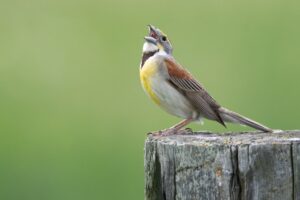Get To Know This Year’s Featured World Migratory Bird Day Species: Dickcissel

Vital Signs
Common name: Dickcissel
Latin name: Spiza Americana
Range: During the summer months, the Dickcissel’s breeding grounds span the Central United States prairies. For the winter, they migrate towards the western coast of Mexico and the North of South America.1
Average Lifespan: 4 years4
Size: Length of 14 to 16 cm with a wingspan of 25 to 26 cm, typically weighs 26 to 38 g2
Population estimate: 28,000,000 globally2
The Facts
The Dickcissel is a small bunting that can usually be found living in grasslands. The Dickcissel has a rather distinctive colour pattern that sets them apart from other birds. The males have brown wings, a gray head and underside, with a deep black spot on its neck and a yellow highlight on its chest. The female Dickcissel looks mostly similar, but lacks the black spot on their neck and has more muted colours.2
While the Dickcissel is classified as part of the cardinal family, their closest relatives are unclear. They are also the only species classified in the genus Spiza. As mentioned above, they live mostly in grasslands and prairies. During the summer, they make their home in the central United States.2 They may also rarely go North enough to enter Canada, it is estimated that there are about 500 to 5000 individuals that make it to Canada in a given year.1 Dickcissels may also change their nesting grounds every year depending on the rain an area receives.2
When making their nests, the Dickcissel usually chooses a location close to the ground in dense grasses and sedges. The female will lay a clutch of 3 to 5 eggs that take 12 to 13 days to hatch. Once hatched, the young Dickcissels will leave the nest after 7 to 10 days, but will only learn to fly a few days later.3
The Story
Globally, the Dickcissel is considered to be a species at low risk of becoming endangered. In the past, they had faced a relatively large decline in their numbers. During winter, they eat almost exclusively seeds and grain, and have been regarded as pests by local farmers. In the 1960s and 1970s, they were targeted by chemical poisoning campaigns by farmers trying to control damage to rice and sorghum crops.1 Today their numbers have stabilized mostly due to stricter regulations concerning pesticide use and wildlife protection, and remain around 28,000,000 individuals globally.2
What you can do
While currently their numbers are stable around the world, like many other species of birds the Dickcissel may be sensitive to habitat loss and climate change. As native grasslands are increasingly converted to hayfield and fallow fields, the Dickcissel risks facing a decline in their numbers. While hayfields have the potential to provide a habitat for the Dickcissel, they are often mowed before their young have time to fledge. In addition, with the increase in droughts caused by global warming, the fertile and vibrant grasslands that the Dickcissel prefers are further put at risk.2
All things considered, advocating for the conservation of grasslands in Canada, and conserving nature, in general, are great ways you can help to support the Dickcissel.
You can also get involved with a local Bird Team in your community to work towards becoming Bird Friendly City Certified or host and participate in an upcoming World Migratory Bird Day event near you! You can also contact your City Council and urge them to join cities like Vaughan, Barrie, and Vancouver, to proclaim their support of World Migratory Bird Day.
Sources:
1 Canadian Wildlife Service Waterfowl Committee. 2015. Dickcissel (Spiza americana). https://wildlife-species.canada.ca/bird-status/oiseau-bird-eng.aspx?sY=2019&sL=e&sM=a&sB=DICK
2 The Cornell Lab. All About Birds, Dickcissel. https://www.allaboutbirds.org/guide/Dickcissel/overview
3 Audubon. Guide to North American Birds, Dickcissel. https://www.audubon.org/field-guide/bird/dickcissel
4 Bird Watching Academy. Bird identification, Dickcissel. https://www.birdwatchingacademy.com/dickcissel/
This project was undertaken with the financial support of the Government of Canada through the federal Department of Environment and Climate Change.
Ce projet a été réalisé avec l’appui financier du gouvernement du Canada agissant par l’entremise du ministère fédéral de l’Environnement et du Changement climatique.




